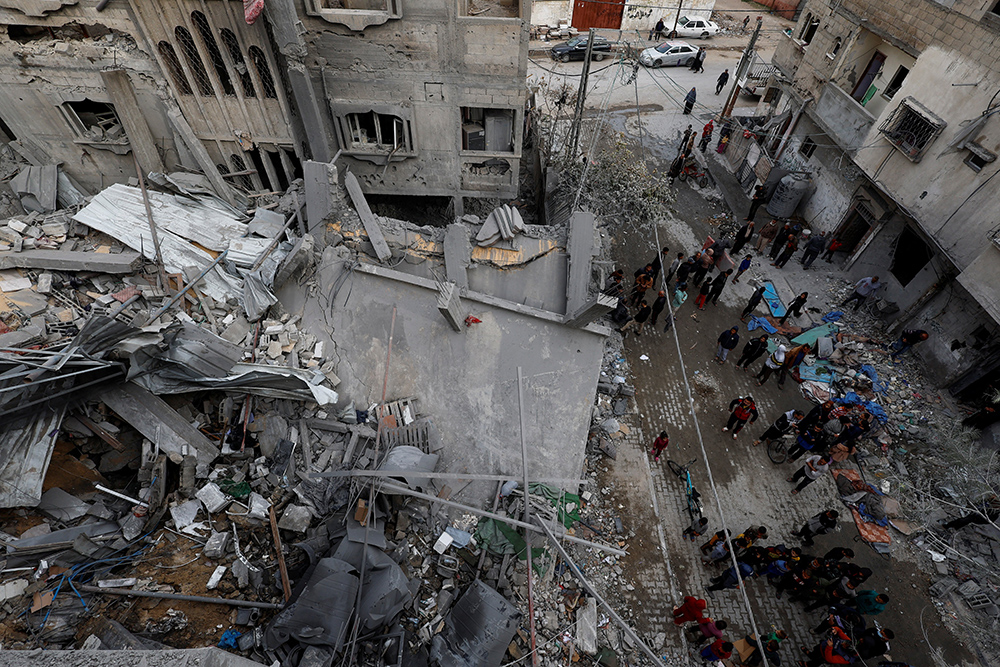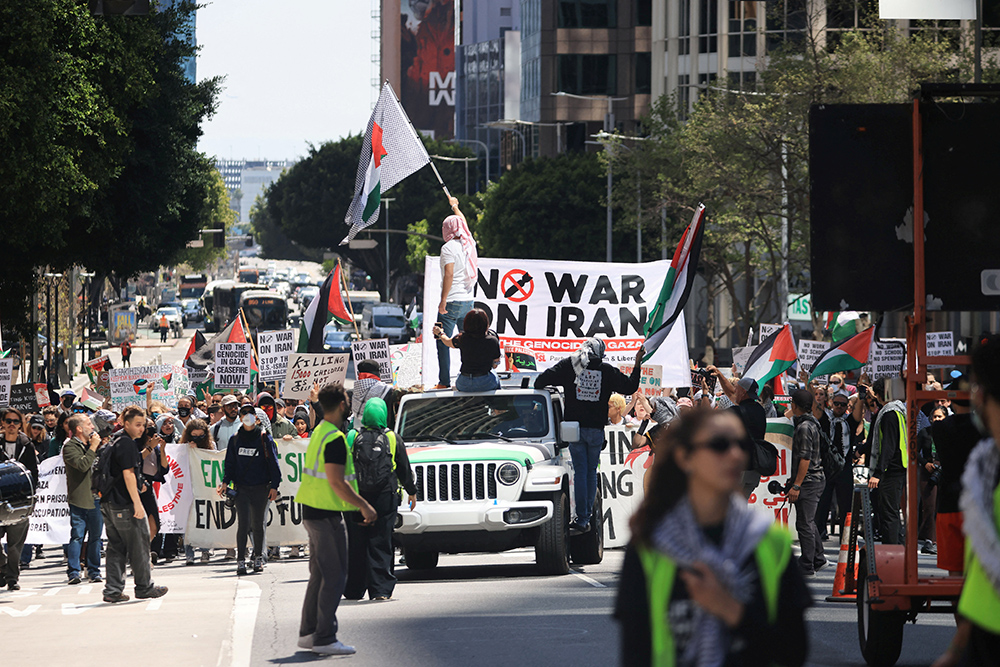
Palestinians inspect the site of Israeli airstrike on a house, amid the ongoing conflict between Israel and the Palestinian Islamist group Hamas, in Rafah, in the southern Gaza Strip, March 24, 2024. (OSV News/Reuters/Mohammed Salem)
It is easy to despair over the Holy Land. For almost 80 years it has been a festering sore, and today, after decades of peace efforts, there is no end in sight.
After the genocide inflicted on Jews by the Nazis during World War II, Jews wanted a homeland where they could be self-governing and safe. Returning to Israel, their original homeland until the destruction of the Jewish state by the Roman Empire, was a longed-for hope.
For a variety of reasons (guilt, sympathy, geopolitical gamesmanship and even antisemitism), the West supported a Jewish homeland. Worries about the Palestinians currently living in what had been ancient Israel were put aside.
From a nation of refugees surrounded by enemies, Israel has grown into an economic and military powerhouse. A democratic ally to the United States, it has come to be seen as a bulwark against Iran.
Advertisement
But the Palestinian question remains. Many were pushed as refugees into Jordan. Others live under dire circumstances in the West Bank and Gaza. Angry at the loss of their land and independence, many have turned to violence. In a search for its own security, Israel has responded to violence with even more violence in an endless cycle that has no foreseeable conclusion.
International experts, including those in the Vatican, have insisted on a two-state solution where Palestinians gain sovereignty over the West Bank and Gaza in return for long-term peace for the Israelis. After previous steps toward the two-state solution have faltered, Israeli settlers have now occupied so much Palestinian territory as to make this impossible without their removal.
The terrorist actions of some settlers toward Palestinians have made peace more remote, while the Israeli government, turning a blind eye to settler attacks, severely punishes teenage Palestinians who throw rocks.
Corruption and incompetence among Palestinian politicians have made the two-state solution more difficult. Disillusioned, Palestinians in Gaza turned years ago to Hamas leaders who seek the destruction of Israel through terrorism and violence.
The latest war in Gaza was begun by Hamas, which attacked Israel, slaughtered civilians and kidnapped hostages. Israel's military response went far past the usual retaliatory attacks, aimed at vanquishing Hamas once and for all. Tens of thousands of civilians have been killed, cities leveled. Women and children are now starving as refugees in the south of Gaza. Almost all food and other supplies are being held up at the border. One war crime (taking of civilian hostages) does not legitimate another (the starving of civilians).

Members of the World Central Kitchen prepare food for Palestinians in a location given as Gaza amid the ongoing conflict between Israel and Hamas, in this picture released on March 21, 2024 and obtained from social media. (OSV News/Courtesy of @chefjoseandres via X via Reuters)
The United States continues to call for a two-state solution while supplying Israel with billions of dollars in weapons and ammunition. Some Palestinians, meanwhile, have taken up the slogan "from the river to the sea," even as some Israelis advocate pushing the remaining Palestinians from Gaza into Egypt and establishing a "Greater Israel," its own version of "from the river to the sea."
It is time for the United States to limit military aid to Israel to defensive weapons — continuing to supply Israel with anti-missile protection but preventing the use of our 500-pound bombs in Gaza, where they have resulted in widespread destruction and numerous civilian casualties.
Though it may have little impact on the war, such limits would send a signal that Israel must be more careful to avoid civilian casualties. We must insist that Israel allow food aid into Gaza.
American presidents have long failed to bring peace to the area, though a few, Jimmy Carter most of all, made incremental progress. But the land is at a tipping point. If Israel attacks the Gaza city of Rafah, where almost half of Gaza's 2.3 million population have sought refuge, it will be a humanitarian catastrophe. If it results in pushing the remaining Palestinians into Egypt, which does not want them, such an attack will destabilize Egypt and provide another place for cross-border attacks on Israel.
Though a desire to destroy Hamas is understandable, Israel should remember that the United States felt the same way about al-Qaeda. After it was destroyed, ISIS took its place. Destroying Hamas will not bring peace to Israel. Though Israel doesn't want to negotiate with Hamas, it needs to remember that you negotiate with your enemies, not your friends.
Israel has squandered the sympathy of the world by its excessive use of force in Gaza. In the United States, 55% of the American people disapprove of Israel's actions in Gaza, according to Gallup, while only 36% approve. Students are demonstrating against the war on college campuses, mostly nonviolently, but with some excesses we have come to expect from students.
It would be easy to give up on our own ability to talk about the Holy Land. Having lived through the protests against the Vietnam War, I am saddened that today's college administrators, students and media are making the same mistakes as those of an earlier era.

Pro-Palestinian demonstrators march through downtown streets and shopping malls during a "Strike for Gaza" protest in Los Angeles April 15, 2024. (OSV News/Reuters/David Swanson)
Demonstrators need to police themselves so that the extremists who speak loudest do not appear to speak for all. They should do more singing and less shouting. They should express love, not hate. They should not alienate their fellow students by interrupting classes or graduation. The goal is to win people over to their side, not merely to vent anger.
Administrators should avoid calling the police, and instead encourage dialogue and discussion. They should encourage faculty to debate the issues. They should defend free speech but oppose violence.
And the media need to focus on the big picture, not the few excesses. They need to interview real students and campus leaders, not just the loudmouths. Sadly, it is still true that "If it bleeds, it leads."
History gives us little reason to hope. Older Americans remember the disaster that was the 1968 Democratic Convention in Chicago. Its anti-war demonstrations and police violence led to the defeat of Hubert Humphrey by Richard Nixon, who continued the war until 1975.
Now, 56 years later, the Democrats are meeting in Chicago again. Chaos at this year's convention could kill President Joe Biden's chances of reelection and ensure victory for Donald Trump, who has promised to let Israel do whatever it wants.
So far, Biden has had little success in getting Benjamin Netanyahu to stop making war on Palestinian civilians. There is a glimmer of light in that Israel has allowed a few more aid trucks into Gaza and Hamas leaders have arrived in Egypt for talks. We have to persevere and have hope because the alternative is too terrible to imagine.





